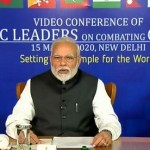A tweet by Prime Minister Narendra Modi resulted in the first-ever virtual summit of leaders from the South Asian Association for Regional Cooperation leaders on March 15. Their deliberations reflected recognition of the serious menace posed by COVID-19 and the need for robust regional cooperation to overcome it. What has happened to this innovative exercise in health diplomacy since then?
Those who hastened to dismiss the video conference as mere show may have been disappointed. Considering that the South Asian Association for Regional Cooperation has been dormant for several years due to regional tensions, it is worth stressing that the fight against COVID-19 has been taken up in right earnest through a series of tangible measures.
Well-represented participation
First, all the eight member-states were represented at the video conference — all at the level of head of state or government, except Pakistan. The Secretary General of SAARC participated. They readily agreed to work together to contain the virus, and shared their experiences and perspectives.
Second, India’s proposal to launch a COVID-19 Emergency Fund was given a positive reception. Within days, all the countries, except Pakistan, contributed to it voluntarily, bringing the total contribution to $18.8 million. Although it is a modest amount, the spirit of readily expressed solidarity behind it matters.
Third, the fund has already been operationalised. It is controlled neither by India nor by the Secretariat. It is learnt that each contributing member-state is responsible for approval and disbursement of funds in response to requests received from others.
Fourth, in the domain of implementation, India is in the lead, with its initial contribution of $10 million. It has received requests for medical equipment, medicines, and other supplies from Bhutan, Nepal, Afghanistan, Maldives, Bangladesh and Sri Lanka. Many requests have already been accepted and action has been taken, whereas others are under implementation.
Fifth, a follow-up video-conference of senior health officials was held on March 26. The agenda included issues ranging from specific protocols dealing with screening at entry points and contact tracing to online training capsules for emergency response teams. Steps are now under way to nurture technical cooperation through a shared electronic platform as also to organise exchange of all useful information among health professionals through more informal means.
Those who argue that SAARC members have committed rather limited resources for a grave threat have a point. But they need to study the latest figures which reveal an interesting picture. So far, South Asia has not exactly borne the brunt of the pandemic. Of the total confirmed cases in the world that stood at 12,89,380 on April 6 (according to the Johns Hopkins Coronavirus Resources Centre), SAARC countries reported only 8,292 cases, representing 0.64%.
Whether the low share is due to limited testing, a peculiarity of the strain of the virus, people’s unique immunity, South Asia’s climate, decisive measures by governments, or just good fortune, is difficult to say. But it is evident that India’s imaginative diplomacy has leveraged the crisis to create a new mechanism for workable cooperation. It will become stronger if the crisis deepens and if member-states see the advantages of working together. Seven of the eight members already do.
Dawn of a new SAARC?
To conclude that SAARC is now returning to an active phase on a broad front may, however, be premature. This must be seen against the backdrop of New Delhi having invested political capital in strengthening the Bay of Bengal Initiative for Multi-Sectoral Technical and Economic Cooperation (BIMSTEC) while Nepal and Sri Lanka recently urged India to resuscitate SAARC. As if in clarification, External Affairs Minister S. Jaishankar said at a public forum that India had no preference for any specific platform, but was fully committed to the cause of regional cooperation and connectivity. The challenge facing the region is how to relate to a country which claims to favour regional cooperation, while working against it. Clearly, India has little difficulty in cooperating with like-minded neighbours, as it showed by forging unity in the war against COVID-19. This is diplomatic resilience and leadership at its best.
Finally, ‘SAARC purists’, who maintain that all proposals for cooperation should be routed through the Secretariat and activities should be piloted by the incumbent chair, may want to consider that given the manner in which Pakistan has tried to harm India’s interests since the terrorist attack on the Uri army base in 2016 and its continuing resistance to cooperation against COVID-19, the scenario they envision is unrealistic. Both New Delhi and its friendly neighbours need to start preparing themselves for SAARC 2.0.
Rajiv Bhatia is Distinguished Fellow, Gateway House, and a former Ambassador. While at the Ministry of External Affairs, he headed the division which handled India’s relations with four neighbouring countries.
This article was originally published by The Hindu.


